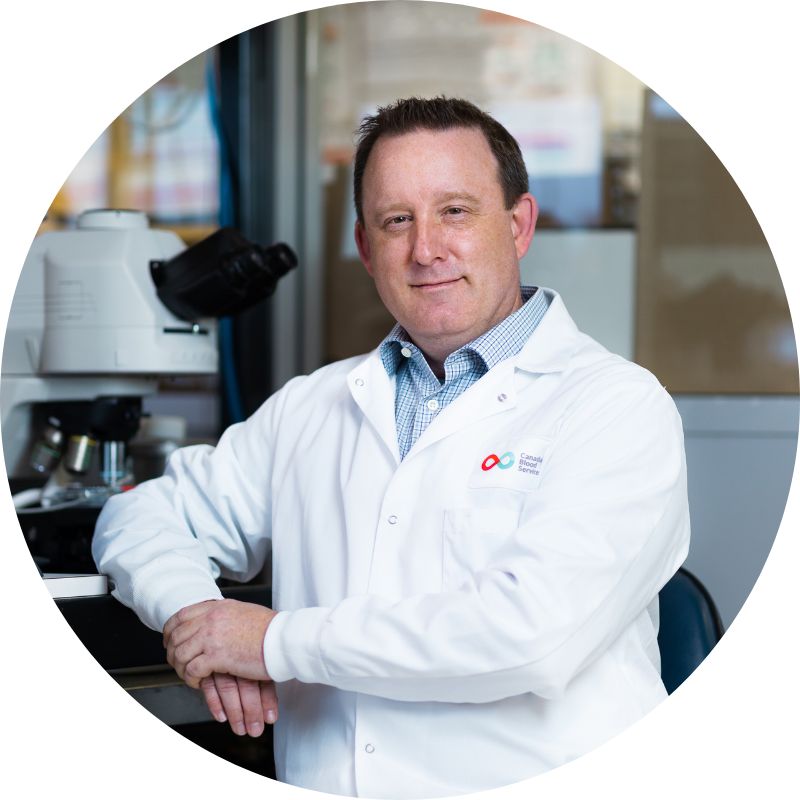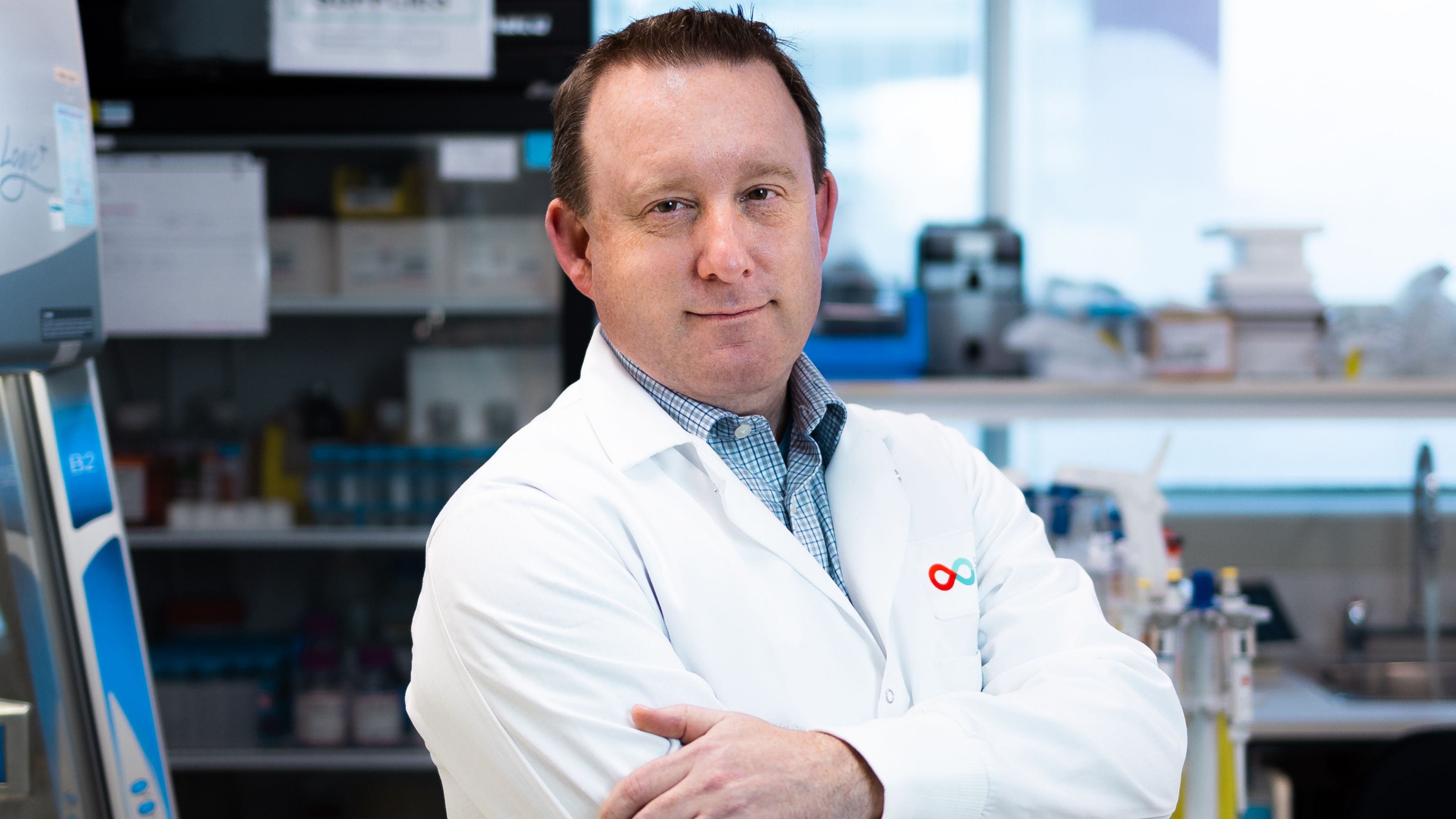As the Senior Research Scientist with the Canadian Blood Services’ Centre for Innovation and a Professor in the Department of Laboratory Medicine and Pathology at the University of Alberta, Dr. Jason Acker has responsibility for developing scientific and technical evidence to support innovative changes in blood product manufacturing, storage and utilization at Canadian Blood Services.
In this week’s spotlight, Jason shares how an understanding of natural systems and collaboration across disciplines can lead to innovative applications in the stabilization of cell-based therapies and beyond.
How do you describe your work to people who don’t work in your field?
Cells are the future medicines that will be used to treat and cure disease. One of the challenges in delivering these new medicines to patients is their requirement to be stored at low temperatures. As a scientist, my research has focused on understanding how natural systems survive freezing and thawing (ie. during the winter) and how we can apply those strategies to the stabilization of cell-based therapies. This research has resulted in us discovering new technologies that we have translated into new processes for cryopreserving cells and commercial products that aid in stabilizing and protecting cells during freezing and thawing. We are applying our innovative tools and approaches for cell stabilization to areas outside of cell therapy including animal husbandry, aquaculture and conservation of rare and endangered species.
What’s one big problem you want to solve through your work?
While we can store cells and small tissues at ultra-low temperatures, the big opportunity is to develop strategies that will permit cryopreservation of tissues and organs. Extending the storage time of tissues and organs from the current hours to days or weeks will have a dramatic impact on our ability to meet the needs of organ transplant patients. The University of Alberta is leading the world in transplantation medicine and cryopreservation and working across these disciplines gives us the opportunity to solve this “grand challenge”.
What does the word “innovation” mean to you?
To me innovation is the process of taking new ideas and translating them into changes that have an impact. As an example, my discovery research studying how natural systems produce small cryoprotective molecules has resulted in improved methods and patented tools for the preservation, processing, utilization and global exchange of cell and tissue products used in transfusion/transplantation medicine and research. The impact comes from making this technology available to clinical and commercial cell therapy companies in the form of a product.
What’s been your biggest a-ha moment — in life or work — so far?
Perhaps the most influential discovery that I’ve been fortunate to experience occurred when I was a graduate student at the University of Alberta. We were exploring how ice is formed and grows inside and outside cells using a specialized microscope. I was exploring how the attachment of cells to glass surfaces changed their size and shape and how that contributed to how ice was able to interact with the cell. During one experiment, I miscalculated the number of cells I was to use and the cells clustered together on the glass surface. When frozen, I observed the ice “jump” from inside one cell into the other connected cells. This serendipitous observation has changed how we look at and approach the cryopreservation of complex biological systems including tissues and organs.
How do you or your team come up with your best ideas? (Do you have any rituals or habits that trigger your creative spark, for example? What do you do to create space for innovation?
The best ideas are the ones that are formed after engaging with the diverse group of individuals on my team. I gain great inspiration from working with really smart, engaged and motivated trainees and colleagues.There is nothing more infectious than the energy that comes from interacting with an interdisciplinary team of people with broad experiences and knowledge that are collectively working together to solve hard problems.
What’s your favourite thing about working at the U of A?
The University of Alberta is an outstanding place for discovery and innovation. We have world-class research facilities, integrated clinical research programs, a supportive innovation ecosystem and access to a talented pool of trainees. I am always amazed at the breadth of research that is being done on and off campus and one of my favourite things about working here is the almost daily opportunity to learn something new!
What’s next for you? Do you have any new projects on the horizon?
I have very broad research interests, which in addition to the work we do on cell stabilization, includes advancing studies on the quality and safety of the blood products used in transfusion medicine. My research team is currently working with collaborators to understand how blood donor factors (age, sex, ethnicity, frequency of donation) and changes to donor screening affect the quality of red blood cell products. Our focus has been on understanding the biological effects that donor-associated changes have on blood components to determine if changes to donor screening, blood component manufacturing or storage can be used to enhance the safety and quality of our blood products. In addition, we are contributing to national studies linking data on donors, products and recipient outcomes. With deep learning tools we are using this information to guide clinical studies to better understand transfusion and blood product utilization. In addition, we are working with international partners to develop innovative microfluidic and photo-acoustic tools to examine non-invasively the effects of donor factors on the quality of blood cells.
This conversation has been edited for brevity and clarity.
Innovator Spotlight is a series that introduces you to a faculty or staff member whose big ideas are making a big difference.
Do you know someone who’s breaking boundaries at the U of A? (Maybe it’s you!) We’re interested in hearing from people who are creating new solutions to make our world better. We want to feature people working across all disciplines, whether they’re championing bold ways of thinking, driving discovery or translating insights from the lab into the market.
Get in touch at blog@ualberta.ca.

About Jason
Dr. Jason Acker is the Senior Research Scientist with the Canadian Blood Services’ Centre for Innovation and a Professor in the Department of Laboratory Medicine and Pathology at the University of Alberta, Edmonton, Canada. He also serves as the Academic Director of the Post-Doctoral Fellows and Academic Visitors Office at the University of Alberta.
Dr. Acker is author of more than 200 publications, 10 book chapters and holds 12 patents in the area of cell preservation and microfabrication. Dr. Acker serves as an editorial board member for 4 journals and invited reviewer for more than 35 scientific publications. He is a Fellow and Past-President of the international Society for Cryobiology. Dr. Acker is actively involved in consulting with and advising companies and organizations developing biobanking and cell therapy programs and is co-founder of two University start-up companies.
